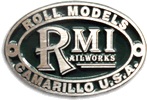Seen on all major railroads, this car was the "office" for the train crew. With the optional removable roof section, this caboose is the perfect accommodation for your flagman.
The most common caboose form in American railroad practice has a small windowed projection on the roof, called the cupola. The crew sat in elevated seats to inspect the train from this perch.
The invention of the cupola caboose is generally attributed to T. B. Watson, a freight conductor on the Chicago and North Western Railway. In 1898, he wrote:
"During the '60s I was a conductor on the C&NW. One day late in the summer of 1863 I received orders to give my caboose to the conductor of a construction train and take an empty boxcar to use as a caboose. This car happened to have a hole in the roof about two feet square. I stacked the lamp and tool boxes under the perforation end and sat with my head and shoulders above the roof ... (Later) I suggested putting a box around the hole with glass in, so I could have a pilot house to sit in and watch the train."
The position of the cupola varied. In most eastern railroad cabooses, the cupola was in the center of the car, but most western railroads preferred to put it toward the end of the car. Some conductors preferred to have the cupola toward the front, others liked it toward the rear of the train, and some just did not care. ATSF conductors could refuse to be assigned to a train if they did not have their cabooses turned to face the way they preferred. However, this would be a rare union agreement clause that could be used, but was not a regular issue.
The classic idea of the "little red caboose" at the end of every train came about when cabooses were painted a reddish-brown; however, some railroads (UP, and NKP, for example) painted their cabooses yellow or red and white. The most notable was the Santa Fe which in the 1960s started a rebuild program for their cabooses in which the cars were painted bright red with an eight-foot-diameter Santa Fe cross herald emblazoned on each side in yellow. Some railroads, chiefly the Wabash Railway, Norfolk and Western and Illinois Central Gulf, also built or upgraded cabooses with streamlined cupolas for better aerodynamics and to project a more modern image.
|



